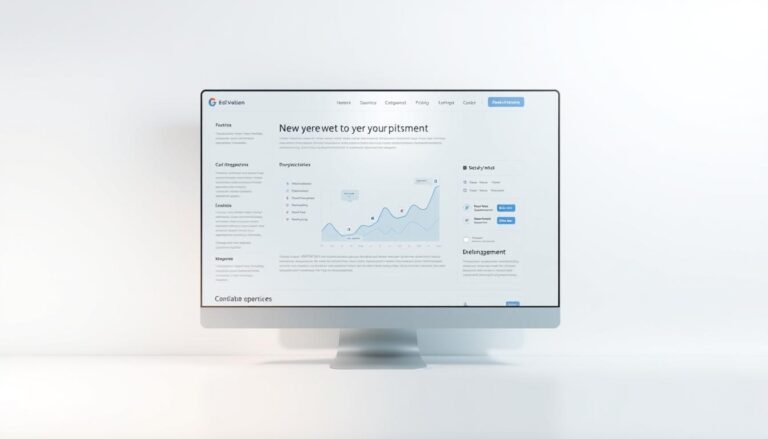In the fast-paced business world, GTM automation’s role in enhancing forecasting accuracy cannot be understated. It acts as a navigator, helping companies grow steadily. It combines insights from marketing, sales, and customer teams. This creates a unified strategy that focuses on winning new customers, keeping them, and growing their business. By applying precise forecasting methods and focusing on important metrics, companies can make smarter decisions. This ensures staying ahead in making accurate predictions is always a top priority.
Key Takeaways
- Improved collaboration among departments is crucial for accurate forecasts.
- GTM automation strategies enhance data integration and analysis.
- Adopting full-funnel approaches leads to better customer insights.
- Successful forecasting relies heavily on key performance indicators.
- Advanced automation tools are essential for informed decision-making.
The Importance of Accurate Forecasting
Forecasting is essential for business success. It helps companies plan how to use their resources and create marketing strategies. It’s not just about guessing sales numbers. Many teams, like marketing and customer support, must work together.
By using information from different areas, businesses can get a clear picture of their health and future.
Understanding Forecasting in Business
Forecasting lets companies predict future trends using past data and current situations. As markets get more complex, making accurate forecasts becomes more critical. Companies that use a variety of data and analytics can better handle uncertainties.
This allows them to adjust their plans quickly.
Key Metrics for Evaluating Forecasts
To judge how well forecasts are doing, we look at several important measurements. Key metrics include:
| Metric | Description |
|---|---|
| Stage Conversion Rates | Measures the percentage of deals advancing to the next stage in the sales pipeline. |
| Deal Velocity | Tracks the time taken for deals to move through the sales process. |
| Pipeline Leakage | Assesses the rate at which potential deals are lost at various stages of the pipeline. |
Common Challenges in Forecasting
There are several hurdles to clear forecasting. These include:
- Human Bias: Personal views can alter the way data is seen.
- Lack of Context: Without deep market knowledge, forecasts might miss new trends.
- Inflexibility: It’s hard to adapt to new info using old models.
What is GTM Automation?
GTM automation mixes various tools and methods, making go-to-market plans run smoother across different parts of a business. It makes operations more efficient by allowing for quick analysis of market moves, how customers act, and sales results.
Definition and Scope of GTM Automation
The gtm automation definition includes using tech to automate marketing and sales tasks. This covers collecting data, analyzing trends, and managing customer relations. With gtm automation tools, companies see better teamwork and coordination, which helps grab market chances.
How GTM Automation Works
GTM automation uses software to gather and look over varied data. These tools help spot what customers like, make campaigns better, and guess sales outcomes. Automated systems make it easier to make quick, informed decisions and increase work output while reducing mistakes.
Benefits of GTM Automation to Businesses
The benefits of gtm automation are many and meaningful. Companies that use these systems can get:
- Improved Operational Efficiency: Automation cuts down on repetitive work, freeing up time for key projects.
- Enhanced Predictive Capabilities: Analyzing data helps predict market and customer behavior more accurately.
- Alignment Between Marketing and Sales: GTM automation helps marketing and sales work together with the same goals.

| Benefit | Description |
|---|---|
| Operational Efficiency | Makes the manual workload lighter, so teams can use their resources better. |
| Predictive Insights | Uses data analysis to guess future customer actions and market trends. |
| Team Alignment | Helps teams work together better by sharing goals and improving communication. |
Integrating GTM Automation into Forecasting
Businesses can get better at predicting and responding by mixing GTM automation with forecasting. This mix involves taking strategic steps. It also means using advanced tools that make work and decisions flow smoothly.
Steps to Implement GTM Automation
To successfully add GTM automation, you need a plan with clear goals. Important steps include:
- Finding processes to automate to make forecasts more accurate.
- Choosing forecasting tools that match what the organization wants.
- Teaching employees how to use these tools, so everyone can make the most of automation.
- Setting up times to check how the forecasting is doing and fixing anything if needed.
Tools and Technologies for Integration
It’s key to use the right GTM automation tools for smooth data sharing. Important tools include:
- Customer Relationship Management (CRM) systems that put all customer info and insights in one place.
- Advanced analytics platforms for deep data study, helping make better market guesses.
- Machine learning algorithms that boost the ability to predict well, making forecasts stronger.
Choosing tools that fit together well makes sure all teams share the same data. This unity helps make forecasting efforts more consistent.
Enhancing Data Quality for Better Forecasts
Good data quality boosts the accuracy of business forecasts. It provides a solid base for making informed choices by showing important patterns. Thus, it’s key for organizations to improve their data’s integrity and relevance for better forecasting results.
The Role of Data in Forecasting
The success of forecasting models depends a lot on the data used. Clean, organized data helps in finding relevant insights. Organizations focusing on data quality tend to get more reliable forecasts and understand market changes better.
Strategies for Data Cleaning and Preparation
Having strong data cleaning strategies is vital. Regular checks keep data accurate, and protocols for data validation keep it consistent and error-free. Removing duplicate entries helps avoid misleading results and makes the data clearer. These steps let organizations create more effective forecasting models.
Leveraging AI and Machine Learning
Using AI in forecasting improves predictions. Machine learning looks at past data to find trends and forecast future events. It helps spot risks early, letting organizations adjust their strategies based on customer and market shifts. With predictive analytics, companies can boost their forecasting precision.

| Data Quality Dimensions | Description | Impact on Forecasting |
|---|---|---|
| Accuracy | Correctness of the data | Ensures predictions align with reality |
| Completeness | Availability of necessary data | Enhances depth of analysis |
| Consistency | Uniformity across datasets | Reduces discrepancies in forecasts |
| Timeliness | Recency of the data | Increases responsiveness to market changes |
Case Studies: Successful GTM Automation Implementation
Looking at real examples of GTM automation shows how it improves how a business works. It brings major benefits, like quicker market reactions and better supply chain management. These stories provide key lessons on the systems that lead to success.
Example 1: Increasing Market Responsiveness
A major company changed its marketing game with GTM automation. By using data smartly, they became quicker at spotting market trends. This agility helped them understand what customers want in no time.
Example 2: Streamlining Supply Chain Processes
A leading maker used GTM automation to make its supply chain smoother. Smart tech like AI-based forecasting cut down on inventory and order times. This made their deliverables more reliable and their customers a lot happier.
| Company | GTM Automation Focus | Outcome |
|---|---|---|
| Marketing Leader | Market Responsiveness | Enhanced decision-making, faster response to market changes |
| Leading Manufacturer | Supply Chain Automation | Improved order fulfillment rates, reduced logistics delays |
Future Trends in Forecasting with GTM Automation
Forecasting is changing fast, thanks to tech like artificial intelligence and machine learning. These technologies are making forecast trends more accurate and quick. Now, companies using real-time data analytics can get ahead. They can quickly change their plans based on the latest market news.
Innovations on the Horizon
GTM automation is being embraced by more organizations. This will bring new, innovative tools that use predictive analytics and AI. These tools will help businesses make smart decisions quickly. Thanks to advanced platforms, there’s now a better way to manage sales and increase efficiency.
The Growing Role of Real-Time Data
Real-time data analytics is key to good forecasting. It lets companies change strategies quickly to match new market trends and what customers want. Tools that show when to reach out to buyers are crucial. They help companies find the best times for making contacts. This helps companies grab chances fast and dodge risks.
Preparing for Emerging Market Trends
Businesses need to stay alert to keep up with market changes. This means using the latest tools and being ready to change how they forecast. Putting money into solutions that use real-time data helps improve forecast accuracy. Being proactive with data and insights makes staff more capable of dealing with uncertainties. For more on this, check out how AI can transform your forecasting.
FAQ
How can GTM automation improve forecasting accuracy?
GTM automation makes forecasting better by making data collection and analysis easier. It brings together insights from marketing, sales, and customer success teams. It also adapts in real-time to match the market.
What are some advanced forecasting techniques with GTM?
Some advanced forecasting techniques include using predictive analytics and machine learning. They also involve automation tools for quick analysis of past data to spot trends and avoid risks.
What key metrics should I focus on for evaluating forecast effectiveness?
Focus on key metrics like stage conversion rates, how fast deals move, pipeline losses, and customer metrics. These include their acquisition, keeping them, and growing their numbers.
What challenges should I be aware of when implementing GTM automation?
Implementing GTM automation has challenges. These include avoiding peoples’ bias in data, understanding market changes, and updating forecasting models quickly.
How do I choose the right GTM automation tools?
Choosing GTM tools means checking if they work with your current systems. They should also offer useful insights and automate your specific forecasting needs well.
What role does data quality play in forecasting accuracy?
Data quality is very important for accurate forecasts. Good data helps organizations find patterns and make smart decisions. This leads to successful outcomes.
Can AI and machine learning enhance forecasting processes?
Yes, AI and machine learning greatly improve forecasting. They automate analyzing data, spot future trends from past data, and foresee risks. This makes predictions more accurate.
How can companies measure the ROI of implementing GTM automation?
Companies can see the ROI of GTM automation by looking at better efficiency and market response. Also, by better inventory and resource management. All these link to improved forecasting.
What future trends should businesses anticipate in forecasting with GTM automation?
Businesses should expect more AI and real-time data use in the future. Staying on top of market trends is also crucial for the best performance.



